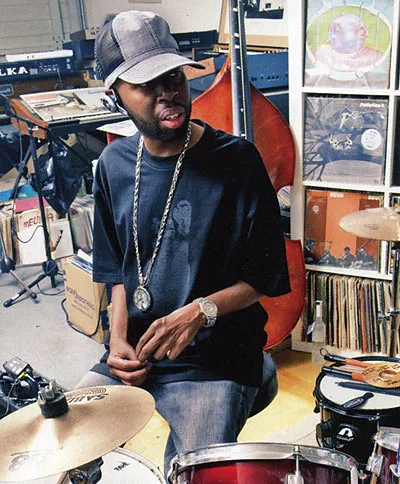James Dewitt Yancey, better known as J Dilla, was a groundbreaking music producer and beat-maker whose inventive contributions to hip-hop and electronic music have left an enduring impact on the music world. His trailblazing approach to crafting music has not only inspired musicians across diverse genres but also, surprisingly and perhaps without even realizing it, programmers. In this article, we will explore how J Dilla’s unique music production techniques have personally inspired me, how they can serve as a source of inspiration for you as well, and the invaluable lessons we can learn from his extraordinary legacy.

The Low-Fi Master:
J Dilla’s production style is synonymous with the low-fi, or lo-fi, sound that has always resonated with me while working. The relaxed, nostalgic, and atmospheric vibe of low-fi music creates a perfect environment for coding, allowing me to focus and remain productive. In this context, low-fi music serves as a soothing background that helps to minimize distractions and maintain a steady workflow. The gentle beats and subtle melodies provide a sense of calm, enabling me to concentrate on complex tasks while fostering a creative mindset.
J Dilla’s signature sound, with its unique blend of seemingly disparate elements, showcases his ability to create a cohesive and harmonious whole. This skill has been a valuable lesson for me, as I often need to integrate various components and systems to build functional and efficient software. By understanding how J Dilla was able to merge different musical elements into a unified composition, I have learned to write code that is not only efficient but also elegant, making it easier for others to understand, maintain, and build upon.
Additionally, J Dilla’s exceptional talent for crafting low-fi music has inspired me to cultivate an atmosphere that promotes creativity within my workspace. This has involved curating a collection of music that resonates with my unique preferences and fosters a sense of inspiration. By immersing myself in an environment that nurtures creativity, I can tap into my own innovative potential and develop novel solutions to the problems I face.
J Dilla’s iconic low-fi production style has served as an inspiration for me in multiple ways. His ability to create a cohesive and harmonious sound has taught me the importance of writing elegant code, while his skill in fostering a creative atmosphere has motivated me to cultivate a workspace that nurtures innovation. By embracing these lessons from J Dilla’s work, I have been able to enhance my productivity and unlock new possibilities within my own projects. So, if you’re a fan of Lofi girl or other lo-fi channels on YouTube, now you know the roots of this captivating genre can be traced back to the pioneering work of J Dilla.
A Programmer of Drums:
J Dilla was not just a music producer; he was a programmer in his own right. With his masterful programming of drums, he showed that the language of programming isn’t limited to JavaScript or Python. In fact, programming transcends traditional boundaries and encompasses a wide range of creative fields, including music production. This broader view of programming is about identifying patterns, understanding their underlying structure, and manipulating them to create something new, innovative, and emotionally resonant.
J Dilla’s unique programming of drums conveyed rhythm and feeling, bringing a new level of emotional depth to his music. He understood the power of each drum sound and its ability to evoke a particular emotion, whether it be excitement, melancholy, or introspection. This attention to detail in drum programming allowed him to create beats that not only sounded great but also conveyed a sense of narrative and emotion. As a programmer, J Dilla approached his craft with a musical ear, using his understanding of rhythm and melody to create drum patterns that were as innovative as they were infectious.

Dilla’s approach to drum programming was unconventional and revolutionary. He often intentionally introduced subtle imperfections and variations in his beats, giving them a human-like quality and making them feel more alive. This technique, known as “quantization,” challenged the prevailing norms in music production and opened up new creative possibilities for beat-makers and producers. So much so that he invented a new technique, the “Dilla Time,” which further cemented his legacy as a pioneer in the music industry.
By doing so, he demonstrated that programming is not just about writing code but also about using programming techniques to create something meaningful and impactful. In this way, J Dilla’s programming of drums serves as a lesson for programmers to approach their work with creativity, nuance, and emotional intelligence, creating software that not only functions but also resonates with users on a deeper level.
J Dilla’s masterful programming of drums showed that music production is not limited to traditional musicianship, and programming is not just about functional code. His approach to music production, where he crafted drum patterns that conveyed rhythm, feeling, and emotion, inspires me to think of programming as a creative art form, where code can be treated as poetry or even sing like music. I strive to imbue my programs with the same level of artistry and emotional resonance that J Dilla brought to his music.
Building on the Work of Others:
Like software developers, J Dilla created magnificent music using the work of previous artists as a foundation. This practice of sampling and remixing can teach programmers the value of collaboration and the importance of acknowledging the contributions of others. As we build on the work of those who came before us and share our own creations, we create a robust and interconnected web of knowledge that fosters growth and innovation.
In the world of software development, this idea is manifested through the use of libraries, frameworks, and protocols crafted by previous generations of developers. For example, a web developer might use the React library, created by Facebook, to build a responsive and interactive user interface, or a data scientist could employ the TensorFlow framework, developed by Google, to implement machine learning algorithms. By leveraging these tools, programmers can save time and effort, avoid reinventing the wheel, and focus on adding unique value to their projects.

Similarly, developers often rely on well-established protocols like HTTP, FTP, or SMTP to enable communication between various components of their software systems. These protocols, designed and refined by experts over the years, serve as the backbone of the internet and facilitate seamless interactions between different technologies and platforms.
Beyond using existing tools and technologies, software developers also contribute to the shared knowledge base by creating open-source projects, writing articles and tutorials, or providing feedback and advice to their peers. By sharing their own expertise and experiences, they help foster a supportive and collaborative community that drives the field forward.
In essence, the practice of building upon the work of others and acknowledging their contributions is an integral part of software development, much like J Dilla’s approach to music production. By embracing this mindset, programmers can tap into a vast pool of resources and knowledge, while also contributing to the collective growth and progress of their industry.
The Power of Adaptation:
J Dilla was known for his remarkable ability to adapt and evolve his production techniques, seamlessly incorporating various styles and genres into his music. As a hip-hop producer, he was heavily influenced by a wide range of musical genres, from jazz to electronic music and beyond, demonstrating a deep appreciation for diverse forms of artistic expression. J Dilla’s willingness to draw inspiration from outside his primary field showcases his open-mindedness and curiosity, which allowed him to continually innovate and push the boundaries of his craft.
This adaptability is a crucial skill for programmers, who must be able to adjust to rapidly changing technologies and methodologies. Much like J Dilla, programmers can benefit from exploring and embracing influences from outside their core discipline. By learning from other industries, art forms, or even different programming paradigms, developers can gain valuable insights and perspectives that can inform their own work and help them stay ahead of the curve in an ever-evolving field.

For example, a programmer working primarily with object-oriented programming languages might explore functional programming concepts, such as immutability or higher-order functions, and incorporate these ideas into their code to improve maintainability and readability. Similarly, a developer experienced in back-end development could delve into the world of user experience design, borrowing principles of good UI design to create more intuitive and user-friendly interfaces for their applications.
Another example could be a programmer who typically works with procedural languages venturing into the realm of logic programming, learning how to write declarative code and adopting techniques like constraint-solving and pattern matching to solve problems more efficiently. By being open to borrowing and integrating concepts from other programming paradigms or languages, developers can enhance their problem-solving skills and produce more elegant, efficient, and versatile code.
J Dilla’s exceptional adaptability and openness to influence from various genres and art forms can serve as a powerful example for programmers. By emulating his willingness to embrace change, explore new creative avenues, and draw inspiration from outside their primary field, developers can cultivate a mindset that enables them to excel in an ever-evolving landscape and make a lasting impact on their industry.
The Epitome of Creativity:
J Dilla’s final album, created during the last days of his life, serves as a testament to his unwavering passion for music and his extraordinary talent. Among the tracks on this album is “Don’t Cry,” a seemingly simple yet deeply moving melody that showcases J Dilla’s exceptional ability to reinterpret and transform existing material. Upon closer examination, it becomes evident that “Don’t Cry” is not just sampling or a remixing of a previously existing song but a complete reinvention of it. J Dilla ingeniously used the original piece as an instrument, extracting its essence and reassembling it into a new and innovative composition. If you want to witness this marvel yourself watch this:
Furthermore, the creation of “Don’t Cry” under such difficult circumstances highlights J Dilla’s unwavering dedication to his craft. Faced with his own mortality, he chose to pour his heart and soul into his music, leaving behind a final masterpiece that continues to inspire countless individuals. This level of commitment and resilience can serve as a powerful reminder for us all to persevere in the face of adversity and to never lose sight of our passions, regardless of the obstacles we may encounter. I have to admit that upon discovering all of this, listening to the song had quite the opposite effect of its title.
J Dilla was like a mad scientist in the studio, taking beats and giving them new life and purpose. Taking music and making it do things it wasn’t supposed to do. It’s like he was saying to the beat, “I don’t care what you’re supposed to sound like, I’m gonna make you sound even better!” This same kind of rebellious spirit can be applied to programming, where developers can take existing tools and technologies and use them in unexpected ways to create innovative software. It reminds me of a client I had. I once built a Learning Management System (LMS) of the and they were so worried about content theft that they wanted to lock everything down. After exhausting all the standard solutions and searching through every plugin and library out there, I had an epiphany: just disable the right click when a user tries to save or copy something from the website! Who needs a context menu anyway? I’m pretty sure even the inventor of JavaScript, Brandon Eich, didn’t see that one coming!
Final thoughts
J Dilla’s extraordinary work in music production serves as an enduring source of inspiration for programmers and artists alike. His unique approach to creating music, his ability to build on the work of others, his adaptability, and his unyielding creativity provide valuable lessons for those who seek to innovate and leave their own mark on the world. By adopting J Dilla’s mindset and learning from his exceptional legacy, we can become the inspirations for the software developers and artists of the future.
These resources offer additional insights into J Dilla’s life, his creative process, and his lasting impact on the music industry. By studying his techniques and learning from his experiences, programmers can find inspiration and motivation to push the boundaries of their own work.
J Dilla’s creative genius, perseverance, and innovative spirit are truly inspiring, motivating programmers and other artists to strive for excellence in their work. Learning from his example can push us to work harder and seek new ways to express our creativity. By understanding how J Dilla managed to break boundaries, experiment with new techniques, and collaborate with others, we can apply these valuable lessons to our own projects and ultimately elevate the quality of our work.
The motivational aspect of J Dilla’s story is especially powerful when considering the challenges he faced throughout his life, including his deteriorating health. Despite these obstacles, J Dilla remained dedicated to his craft, even producing his final album from his hospital bed. This level of dedication serves as a reminder that with passion and perseverance, we can overcome challenges and achieve greatness in our chosen fields.
Essential Albums and Songs to Experience:
If you’re new to J Dilla’s work or simply want to revisit his masterpieces, here’s a list of some of his most special albums and songs that you should listen to:
Album: “Donuts” (2006)
Songs to check out: I wanted to mention a couple of outstanding ones but it’s impossible — just put it on repeat
Album: “The Shining” (2006)
Songs to check out: “E=MC2,” “So Far to Go,” “Won’t Do”
Album: “Ruff Draft” (2003)
Songs to check out: “Nothing Like This,” “Make’em NV,” “Crushin’”
Album: “Jay Love Japan” (2007)
Songs to check out: “Can’t You See,” “Say It!,” “First Time”
Album: “Welcome 2 Detroit” (2001)
Songs to check out: “Think Twice,” “Rico Suave Bossa Nova,” “BBE (Big Booty Express)”

